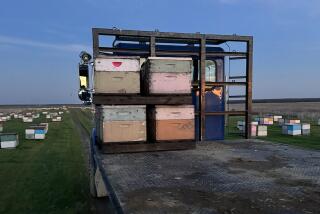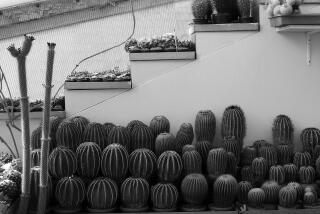Officials Use Novel Ways to Get at Root of Ginseng Poaching
- Share via
WAYNESVILLE, N.C. — Bernard Singleton wonders who slipped past his white lattice fence and dug up his garden. His neighbors heard nothing. His dog did not bark. But one night not long ago, someone cleaned him out.
The loot: ginseng. Its worth: $2,500.
Green gold, they call it. No other herb growing in the woods hereabouts is worth as much. For centuries, Asians have revered its gnarly, pale roots for their supposed invigorating and rejuvenating powers--so much so that the wild crop in that part of the world is nearly gone.
So it’s ginseng from America they now crave. Not the wimpy, cultivated variety. They want the thicker, larger, wild plants. Nearly 90% of the wild ginseng harvested in the United States--most of it grown in the South--goes to Asia. Demand has driven prices skyward--to $350 or more per pound. That has turned America’s national parks--where harvesting is illegal--into a poachers’ paradise.
In the last nine years, say officials at the Great Smoky Mountains National Park--which straddles North Carolina and Tennessee--poachers have made off with about $5.3 million worth of ginseng.
The national forests also have proved to be fertile ground for poachers. And Southerners who grow ginseng on their private property often are victims.
Singleton, who at 70 is tall and frail, loved his ginseng patch. He had more than 100 plants in his yard when the poachers sneaked in after dark on Sept. 17. He’d been growing them for nearly 20 years.
The thieves took exactly what they had come for: the thick roots. They littered the ground with wilted leaves and broken stems as they rushed away.
At the other end of the Blue Ridge Parkway, up in Virginia, six people were prosecuted last month for removing ginseng plants from federally protected lands. They were fined and ordered to pay restitution. For one of the thieves, it was his second conviction.
Jim Corbin, plant specialist for the North Carolina Department of Agriculture, isn’t surprised at second convictions. He knows how hard it is for some people to turn away from the profits reaped by poaching.
“Once they dip their hand in the pot, they can’t keep it out,” Corbin said. “But they are going to be a lot more cautious [the second time]. They’ll find different hunting grounds.”
He knows firsthand the difficulty of prosecuting poaching cases.
Back in 1993, Corbin was asked to testify in a case involving two men arrested in Great Smoky Mountains National Park. They had been apprehended on the park boundary, carrying nearly two pounds of ginseng. They testified that they had found the plants on adjoining land where it was legal to harvest, and didn’t realize they had strayed into the park. The court felt there was enough reasonable doubt to exonerate them.
Corbin was furious. “A plant can’t stand up and say, ‘I came from Joe Blow’s patch,’ ” he said. But it set him to thinking of a way to mark ginseng so that there would be no question about its origin.
First, Corbin tried attaching tiny metal strips with ancient Navajo symbols to the plants’ roots. But the encryption was so small, it required a microscope to read it. Too cumbersome.
Next he requested hundreds of soil samples from ginseng-growing areas and analyzed them. The data showed that the ginseng plants thrived on calcium and magnesium. So he mixed these two minerals with an orange dye laced with coded silicone chips.
The coding was his secret weapon. It identified the origin of the plant.
Corbin took to the woods in 1995 with a team of state and federal employees. Wherever they found ginseng, they uncovered the roots, sprayed them with glue, sprinkled on the dye and then gently re-covered the roots with dirt.
At the first rainfall, the roots absorbed the dye.
Bingo.
The orange coloring was permanent. Soap and water would not wash it away. There was no way to cut it out.
(Corbin’s formula is now at work battling poachers in Tennessee, Kentucky, Virginia, Ohio, Indiana, New York, Missouri and in the province of Ontario, Canada. Arizona has adopted it for tagging petrified wood.)
Ginseng dealers across North Carolina were alerted to watch for orange roots. And if officials with the U.S. Fish and Wildlife Service--which monitors the export of ginseng--spot any orange roots, the entire shipment is returned to the dealer.
Corbin’s orange dye seems to be working. Several North Carolina dealers say that they have seen no orange roots this year.
“I did see some last year,” said Wayne King, owner of the Carolina Bait Shop in nearby Canton. His shop is headquarters for his three businesses: selling live bait, buying ginseng and logging. At one end of the store, residents sat, smoked and chatted about ginseng--or “‘sang” as they call it here.
One went to a back room and brought out a large plastic bag filled almost to the top with thick ginseng roots. “That’s about 30 pounds,” King said. He paid $350 a pound for them but refuses to admit how much he makes off their sale.
On the counter is a clipboard filled with state agricultural forms. King must log the name of every root seller and the county where the ginseng was collected.
At the end of each ginseng season--which runs from Sept. 1 to April 1--the forms are tallied by Marj Boyer, state ginseng coordinator. A quick review shows how prices and harvest yields fluctuate with the Asian economy.
The record year for wild ginseng in North Carolina was 1997, with a harvest of 11,000 pounds. “That was right after the price went up to $500 a pound,” Boyer said. The price dropped off in 1998 and 1999. The yield for those two seasons totaled 14,200 pounds.
Figuring that an average of 350 plants will produce about one pound of roots, that comes to 8.8 million plants dug up from 30 or so western North Carolina counties. There is no way to know how many of them were poached.
“Ginseng is not listed by our state as endangered or threatened,” Boyer said. “But since it is exploited so heavily, it is kind of a special problem.”
Gary Kauffman and Allison Schwarz, botanists with the U.S. Forest Service, are members of Corbin’s team. “The ‘sang gang” spent the summer marking ginseng and other native plants.
On a recent sunny afternoon, they drove into the Shining Rock Wilderness, about 13 miles south of here. Kauffman was armed with the tagging equipment: a can of spray glue in his right pocket, a vial of orange dye stuffed in the left.
After a short hike, they started a steep ascent. They know the leaves on ginseng have yellowed. Once they fall, it will be impossible to find the plants until spring.
Climbing carefully up a dry rock waterfall, they reached a plateau. “This is where it likes to grow,” Kauffman said, pointing to a bowl-shaped area. “It stays moist here, and there’s a lot of diversity of herbs.”
He knelt beside a small bloodroot. He brushed dirt from its roots, sprayed them with glue, sprinkled on the bright orange dye and patted the earth back into place.
“Here is where it was,” shouted Schwarz. “A big plant was here.” The person who dug the ginseng up had placed a rock there to disguise the hole.
“Now you know what we’re up against.”
John Garrison, a National Parks ranger, works with Kauffman, Schwarz and others in the marking group. During his 18 years as a ranger, he has watched the poaching level increase dramatically.
Until the last few years, Garrison said, he didn’t think much about people stealing ginseng. He would give them a ticket and send them on their way. Then he started apprehending people who were camping out for days for the sole purpose of collecting ginseng.
“I grew up in these mountains, where ginseng gathering went on. It was a source of income. It was Christmas money,” he said. “[Now] we’re not talking about that level of activity. We’re talking about people who are taking everything.”
The people, for instance, who dug up Singleton’s plants. They took everything--including his passion for ginseng.
“I was growing it to get the seed,” Singleton said. “Every year I took the seed back in the mountains and scattered it out.
“I ain’t going to fuss with it any more.”
More to Read
Sign up for Essential California
The most important California stories and recommendations in your inbox every morning.
You may occasionally receive promotional content from the Los Angeles Times.













